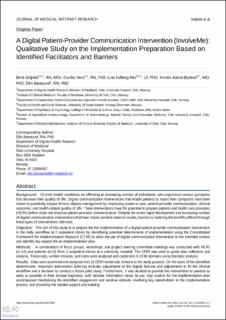| dc.contributor.author | Seljelid, Berit | |
| dc.contributor.author | Varsi, Cecilie | |
| dc.contributor.author | Solberg Nes, Lise | |
| dc.contributor.author | Øystese, Kristin Astrid | |
| dc.contributor.author | Børøsund, Elin | |
| dc.date.accessioned | 2021-09-20T12:20:33Z | |
| dc.date.available | 2021-09-20T12:20:33Z | |
| dc.date.created | 2021-08-18T09:32:46Z | |
| dc.date.issued | 2021 | |
| dc.identifier.citation | Seljelid, B., Varsi, C., Nes, L. S., Øystese, K. A., & Børøsund, E. (2021). A Digital Patient-Provider Communication Intervention (InvolveMe): Qualitative Study on the Implementation Preparation Based on Identified Facilitators and Barriers. Journal of Medical Internet Research, 23(4), Artikkel e22399. | en_US |
| dc.identifier.issn | 1438-8871 | |
| dc.identifier.uri | https://hdl.handle.net/11250/2779217 | |
| dc.description.abstract | Background: Chronic health conditions are affecting an increasing number of individuals, who experience various symptoms that decrease their quality of life. Digital communication interventions that enable patients to report their symptoms have been shown to positively impact chronic disease management by improving access to care, patient-provider communication, clinical outcomes, and health-related quality of life. These interventions have the potential to prepare patients and health care providers (HCPs) before visits and improve patient-provider communication. Despite the recent rapid development and increasing number of digital communication interventions that have shown positive research results, barriers to realizing the benefits offered through these types of interventions still exist.
Objective: The aim of this study is to prepare for the implementation of a digital patient-provider communication intervention in the daily workflow at 2 outpatient clinics by identifying potential determinants of implementation using the Consolidated Framework for Implementation Research (CFIR) to tailor the use of digital communication intervention to the intended context and identify key aspects for an implementation plan.
Methods: A combination of focus groups, workshops, and project steering committee meetings was conducted with HCPs (n=14) and patients (n=2) from 2 outpatient clinics at a university hospital. The CFIR was used to guide data collection and analysis. Transcripts, written minutes, and notes were analyzed and coded into 5 CFIR domains using thematic analysis.
Results: Data were examined and analyzed into 18 CFIR constructs relevant to the study purpose. On the basis of the identified determinants, important intervention tailoring includes adjustments to the digital features and adjustments to fit the clinical workflow and a decision to conduct a future pilot study. Furthermore, it was decided to provide the intervention to patients as early as possible in their disease trajectory, with tailored information about its use. Key aspects for the implementation plan encompassed maintaining the identified engagement and positive attitude, involving key stakeholders in the implementation process, and providing the needed support and training.
Conclusions: This study offers insight into the involvement of stakeholders in the tailoring and implementation planning of a digital communication intervention in clinical practice. Stakeholder involvement in the identification of implementation facilitators and barriers can contribute to the tailoring of digital communication interventions and how they are used and can also inform systematic and targeted implementation planning. | en_US |
| dc.language.iso | eng | en_US |
| dc.rights | Navngivelse 4.0 Internasjonal | * |
| dc.rights.uri | http://creativecommons.org/licenses/by/4.0/deed.no | * |
| dc.title | A digital patient-provider communication intervention (involveme): Qualitative study on the implementation preparation based on identified facilitators and barriers | en_US |
| dc.type | Journal article | en_US |
| dc.type | Peer reviewed | en_US |
| dc.description.version | publishedVersion | en_US |
| dc.rights.holder | © Berit Seljelid, Cecilie Varsi, Lise Solberg Nes, Kristin Astrid Øystese, Elin Børøsund. | en_US |
| dc.source.volume | 23 | en_US |
| dc.source.journal | Journal of Medical Internet Research | en_US |
| dc.source.issue | 4 | en_US |
| dc.identifier.doi | https://doi.org/10.2196/22399 | |
| dc.identifier.cristin | 1926855 | |
| dc.source.articlenumber | e22399 | en_US |
| cristin.ispublished | true | |
| cristin.fulltext | original | |
| cristin.qualitycode | 2 | |

